Sewing Garment - Types of Sleeves | 11th Textiles and Dress Designing : Chapter 13 : Sewing Garment Details
Chapter: 11th Textiles and Dress Designing : Chapter 13 : Sewing Garment Details
Types of Sleeves
Types of Sleeves
Sleeves vary depending upon type of gar-ment, the fabric used, one’s preferences and needs. The length of the sleeve and fullness in sleeves can be altered, to create new designs.
Parts of Sleeve
· Cap line – around the arm, where the arm is separated from the body.
· Side seam – where the sleeve is joined to form a tubular structure.
· Hem line – finished edge of the sleeve.
· Upper sleeve round – around the fullest part of sleeve.
· Elbow round – around the fullest part of elbow.
· Wrist round – around the part of the arm where the palm starts.
Sleeves are classified as set in sleeve and open construction sleeve based upon the method of sewing. Set in sleeves are sleeves in which the side seams are attached to form a circular structure. Then it is attached to the bodice front and back which has to set into the armhole of bodice blocks. Therefore it is known as set in sleeve.
Example: Sari blouse.
Open construction sleeves are sleeves in which the sleeve is first attached to the armscye of the bodices front and back. Then the sleeves and bodices side seams are stitched as a straight line.
Example: Men’s shirt sleeve.
Plain Sleeve
This is also known as basic sleeve. It is used in all garments and more popular in sari blouses. It is plain without any fullness and fits correctly around the armscye and falls over the upper arm. The length of the sleeve varies depend-ing upon the designers taste (Figure 13.2).
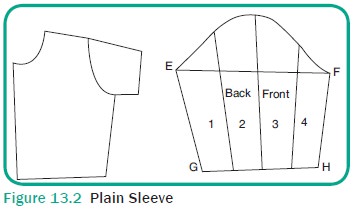
Gathered Sleeves
Gathered Sleeves is a type of sleeve which is also called puff sleeve. It is mostly used in dresses and women’s blouses. It has fullness either at the top edge or at both, the top and bottom of sleeve part. The drafting pattern for sleeves with gathers at the top is prepared using the basic sleeve pattern. The top of the sleeve is slashed almost till the bottom hem line. The pattern is placed over another sheet of paper with the slashed parts spread open according to the amount of gathers required with 3 to 5 cm. extra on top for puffing. The outline is drawn on the new sheet and the pattern is cut (Figure 13.3). The process is reversed for puff at bottom.
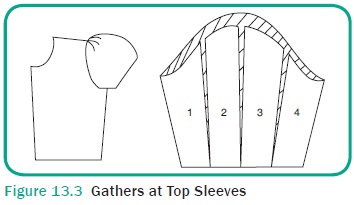
For sleeves with gathers at both the top and the bottom, the basic sleeve pattern is slashed till the bottom edge of the sleeve. The four parts of the sleeves are spread apart on a new sheet with the sleeve cap in line. The patterns are placed with 3 to 5 cm extra at top and at the bottom for puffing. Sometimes, the bottom is not gathered and left loose for fullness (Figure 13.4).
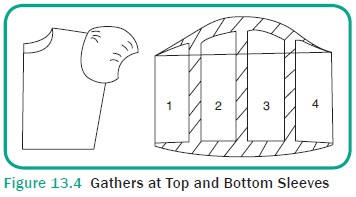
Bell Sleeves
Bell sleeve is also prepared with the pattern of the basic sleeve. The pattern is slashed from the bottom edge (and spread) from the bottom edge to the maximum, for extra fullness. The pattern is drawn on a new sheet and cut. The lower edge is left loose for fullness (Figure 13.5).
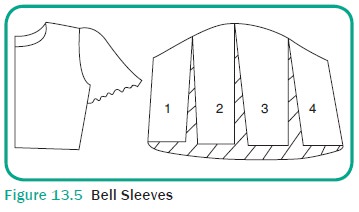
Leg-0-mutton Sleeve
Leg -0-mutton sleeve is puffed at the top and the bottom is tight fitted with gathers. It is also prepared with the basic sleeve pattern. The pattern is cut at the middle of the sleeve horizontally; then a vertical slash is made on the top edge and spread apart. This is kept on a new sheet and a new pattern is drawn and cut (Figure 13.6).
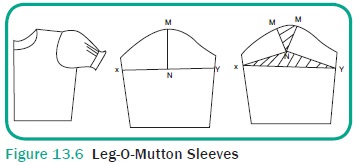
Raglan Sleeve
Raglan sleeve is mostly used for sports-wear, kids wear, T-shirt. It does not have any armhole seam and shoulder seam. Raglan sleeve is also prepared with the basic sleeve and extension are added to the bodies from and back patterns to draft the final raglan sleeve pattern.
Mark point D, 2.5cm above the under arm and A, 2.5cm away from the shoulder point. A and D are joined with a curve as in the figure. The same proce-dure is followed to draw the curve EFH on bodies back. The top pattern of the bodice is along the curves ABD and EFH. Drawn patterns are placed on a new sheet with the basic sleeve pattern at the bottom, matching the centre point of the pattern. Mark the shoulder points as S and S1 on the bodice front and back. Match them to center of the sleeve point ‘L’. Draw the out-line for raglan sleeve pattern. This sleeve is stitched with seam that runs from the neck line to the armhole line (Figure 13.7).
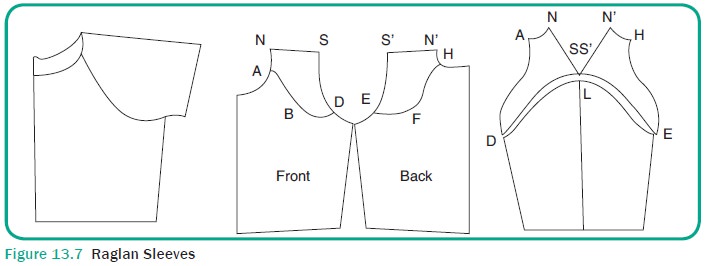
Kimono Sleeve
Kimono sleeves are mostly used in gar-ments where more comfort is needed. It is used mostly for sportswear, kids wear, dance costume and ladies tops. In kimono sleeve there is no seam either at the armhole or in the shoulder. The pattern of the sleeves is cut together with the bodice. Thus the sleeves run from the side seam of sleeve to the side seam of the bodice (Figure 13.8)

Magyar Sleeve
Magyar sleeve is also like kimono sleeve where the bodice pattern is extended from the shoulder line approximately 5 cm outside from the highest point of the shoulder. Lower arm circumference is drawn perpendicular to the bodice pat-tern and attached at the edge of the pat-tern (Figure 13.9).
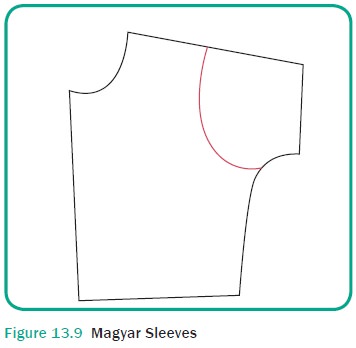
Full Sleeve
A full sleeve pattern is an extension of the basic sleeve pattern but the length of the sleeve is extended till the wrist. The circumference of the sleeve is changed accordingly. Full sleeves are used mostly in women’s wear, kurtas and men’s shirt. In men’s shirt, these sleeves are finished with a cuff at the lower edges (Figure 13.10).
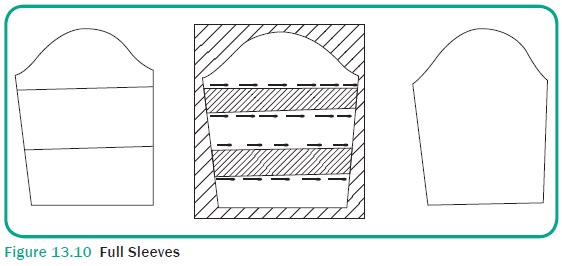
The basic sleeve pattern is cut horizon-tally and spread to get the required length.
Sleeves Till Elbow / ¾ Sleeves
Three fourth sleeve is also an extension of the plain sleeve where the lower edge of the sleeve is extended till the length of the elbow of the wearer. The circumfer-ence is changed according to the wearers taste. Three fourth sleeves are sometimes gathered at the lower edge or left loose. These sleeves are used mainly in wom-en’s wears, kameez tops and kids wear, (Figure 13.11).
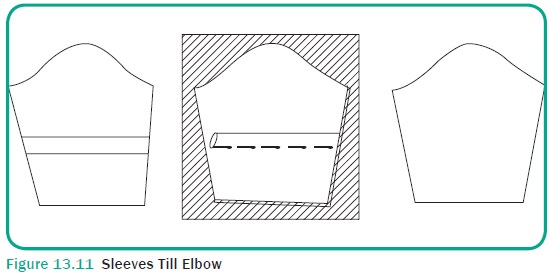
Related Topics